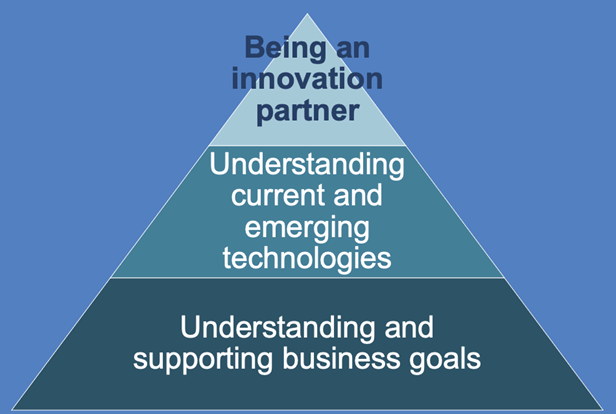Digital Transformation has a definition problem. The term or it’s shortened form, DX, has become so widespread in so many contexts that its meaning has eroded. Part of the Institute’s work is to establish a good working definition. The main point of confusion, I believe, is with the confusion between transformation and change. I use a couple of examples to illustrate:
The Wright Brothers
Most people know that the Wright brothers ran a bicycle shop in Ohio, and also that they produced the first working powered aircraft. That plane took flight in December 1903, the same year William Harley and Arthur Davidson produced their first motorcycle. If the Wright brothers had moved from making bicycles to making motorcycles, that would have been a change. Basically, the only thing needed to accomplish the change is adding an engine to the bicycle.
That is not, however, what the Wrights did. They transformed their little company from making bicycles to making something no one had ever made before.
Both the Wrights and Harley-Davidson used their knowledge of internal combustion engine technology to accomplish their goals. It was not the technology that accomplished the transformation; the technology enabled the transformation. It was the complete reimagining of their products and methods that moved the Wrights from bikes to planes.
Mobile Phones
Although radio-based mobile phones had been around for years (my father’s boss had one in his car in the 60’s and fictional detective Paul Drake uses one on the original Perry Mason series), it is customary to make the advent of modern mobile telephony as 1973, when Motorola introduced the working—if unwieldy—handheld phones. AT&T engineers had been working with cellular technology for years prior to that, but the time was right and cell phones began widespread adoption. By 2000, there were about 740 million subscribers. Today, about 96% of the people in the US have a cellphone.
So, where’s transformation story here? It’s embedded in the culture of how we use telephones (and we are only talking about voice calls at this point). When everyone used landline phones, phone calls were made to a place. “Call me at the office” literally meant that. A hardwired phone rang at someone’s desk. If the person wasn’t at the location, there was no answer. Once cell penetration reached critical mass, calls were to the person rather than the place. Call it a “paradigm shift” if you will, but it is another example of how technology enabled a transformation which has had consequences for our availability, our familial and social habits, and even our ability to cut across organizational structures, paving the way for social media. In India, the wait time for landline phones was once measured in years, while mobile phones were proliferating at the rate of millions per month.
In this case, a change would have produced calling a place, but using a wireless or cell phone. The transformation is that we are all connected in ways we previously were not.
IT as a Capability, Not a Department
Gartner’s Peter Sondergaard famously stated in 2013 that “every company is a technology company.” Although I tend to agree more with the differing viewpoint expressed by Eric Fry, it can’t be denied that Twenty-First Century technology—especially Information Technology—enables business to do business. Websites, inventory systems, Human Resource Information Systems (HRIS), Enterprise Resource Planning (ERP) and Enterprise Service Management (ESM) systems, mobile apps, and so on help businesses hire and manage people and to produce and move goods, services, knowledge, data, and money.
Information Technology is embedded in the way lines of business do work, and people within those lines are the subject matter experts about the technology they use. Increasingly, that technology resides outside the business, in the “cloud.” The infrastructure, whether hardware or software defined, is no longer the sole purview of IT departments, but the governance of the infrastructure and the ability to deliver the software and services organizations require, however, is part of the overall IT capability.
IT, whether we are talking in this case about the department or just the technology itself, is increasingly the mechanism through which your business delivers value to customers. There are three components in play in today’s IT:
- IT (in this case the department) needs to understand and support the goals of the business. This requires good communication in all directions. Break the jargon barriers—and not only IT has them—and get to work understanding how the goals can best be achieved.
- In addition, IT needs to understand current and emerging technology as it relates to those goals. The latest “shiny object” technology is not going to get you where you need to go; thoughtful and business-oriented application of technology is.
- One of the key components of Digital Transformation is innovation. In 2020 and beyond, Information Technology has a huge role to play in creating and delivering innovative products and services to your customers.
 Components of IT Excellence
Components of IT Excellence
When you have information Technology that fully partners with you for innovation, you are enabled to accomplish your Digital Transformation. That transformation, however, has at least as much to do with the culture and structure of your business as it does with the technology. Transformation is not merely change: Think again about the Wright Brothers and Harley-Davidson. The latter became—and still is—a successful business. The other changed everything about the world, including our perception of its size and our ability to access places distant from us.
Your transformational vision begins with what you wish to accomplish, such as putting more power in the hands of your customers, or delivering new services in new ways. How you achieve it, in a world where Information Technology is your bedrock, is at the heart of Digital Transformation.
This post is based in part on a speech Roy made in the Leadership track at Interop Digital.
Tag/s:Digital Disruption





